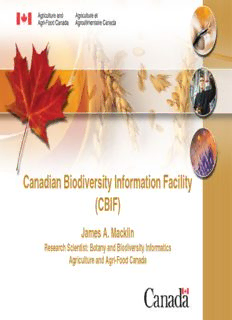
Canadian Biodiversity Information Facility (CBIF) PDF
Preview Canadian Biodiversity Information Facility (CBIF)
Canadian Biodiversity Information Facility (CBIF) James A. Macklin Research Scientist: Botany and Biodiversity Informatics Agriculture and Agri-Food Canada That was then: CBIF • First country-specific portal developed after the creation of GBIF, circa 2001; • Access to specimen and observation data; taxonomic information; e-resources; • Oversight through an interdepartmental group: Federal Biodiversity Information Partnership (FBIP). • Stopped paying GBIF membership in 2012! CBIF: IPT and Canadensys 4 Global nodes GBIF CBIF Academic Biodiversity Portal Group-specific Integrated Taxonomic Information Aggregators: System (ITIS) MaNIS, OrNIS, FishNet, -US & CDN collaboration HerpNet, OBIS AAFC Genetic/Genomic DFO Support & CFIA Aggregators: Infrastructure GenBank, BOLD, CMN NRCan Federal Biodiversity Information Partnership DATA.GC.CA PHAC EC Open Government Action Plan 2 Launched in November 2014, and consists of 12 commitments including Open Science: “The Government of Canada will maximize access to federally- funded scientific research to encourage greater collaboration and engagement with the scientific community, the private sector, and the public.” Open Data core includes: • federal geospatial data • open.canada.ca portal Open Science: • Open Access • Open Scientific Data • Public Engagement source: Action Plan section IV 6 • IT Infrastructure …And this is now: CBIF • A full member of GBIF again after a 5 year hiatus! • Change in oversight to the Integration Board via a Committee on Biodiversity and Collections (2015- ). • 30 million dollars to mobilize AAFC collection data over 6 years… – Includes a new portal for dissemination with resources to develop and support it! BioMob: Mobilizing Biodiversity Data Agriculture and Agri-Food Canada (AAFC) is investing $30 million in Agricultural Science over six years to accelerate the DNA analysis, data capture and imaging of specimens from its collections of over 19 million specimens of insects, plants, fungi, bacteria and nematodes related to these collections. This data will be integrated to improve public accessibility to AAFC’s collections. By 2022, label data capture of six collections will be 100% completed as well as 25% of the Canadian National Collection of Insects, Arachnids and Nematodes. Specimen imaging and DNA sequencing will also be significantly increased. This work supports research in climate change, and rapid identification and prevention of threats to agriculture. Three Work Packages WP1 - Data Capture and WP2 - Molecular Imaging Characterisation • Virtual collections; • Barcodes, partial and complete genome • Complete digital inventories for every sequences where appropriate; collection; • Protocols for high throughput • Enhanced digital information. sequencing and target enrichment; • High throughput computer pipelines to process data. WP3 - Data Integration and Sharing • A centralized Collection Management System; • Knowledge products; • A new AAFC Biodiversity Portal.
Description: